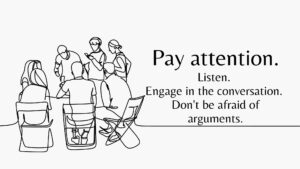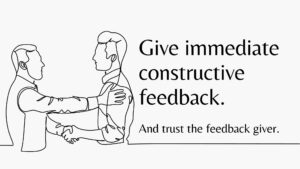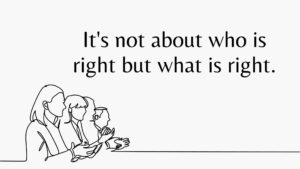Despite its significance, effective communication remains an elusive skill for many. The reason behind this lies in our tendency to emphasize eloquence and linguistic prowess while overlooking the essential element of willingness to communicate. This mindset discourages a lot of people who feel that they are not skilled enough to “communicate”. In this article, we will explore why effective communication is less about eloquence and more about the willingness to connect, understand, and cooperate with one another.
In our society, eloquence and linguistic proficiency are often hailed as the hallmarks of effective communication. People with impressive language skills might excel at expressing their ideas, but this does little to ensure that their message is understood by the receiver, especially if the receiver lacks similar linguistic prowess. It creates a significant communication barrier, leading to misunderstandings, misinterpretations, and ultimately, a failure to achieve the primary goal of communication – a shared understanding and an agreement to get things done.
The Goal of Communication: Shared Understanding and Agreement
The ultimate objective of communication is to establish a shared understanding between the parties involved and to reach an agreement on the matter at hand. This shared understanding forms the foundation for cooperation, problem-solving, and effective decision-making. Without it, conflicts arise, productivity suffers, and relationships become strained.
The Key Attitudinal and Behavioral Competencies in Communication
Willingness to Actively Listen:
- Remove Distractions: When engaging in a conversation, eliminate distractions like phones or other electronic devices. Give the speaker your undivided attention.
- Maintain Eye Contact: Make eye contact with the speaker to show that you are genuinely focused on what they are saying.
- Use Nonverbal Cues: Nodding, smiling, and using appropriate facial expressions demonstrate your engagement and encourage the speaker to continue.
- Avoid Interrupting: Let the speaker finish their thoughts before responding. Interrupting can disrupt the flow of communication and convey disrespect.
- Practice Reflective Listening: Summarize what the speaker said to ensure you understood correctly. This reinforces the idea that you value their input.
 Patience to Explain:
Patience to Explain:
- Assess the Listener’s Knowledge: Gauge the listener’s familiarity with the subject before diving into complex concepts. Tailor your explanations accordingly.
- Use Simple Language: Avoid jargon and technical terms that may be unfamiliar to the listener. Break down complex ideas into simpler terms.
- Ask for Feedback: Encourage the listener to ask questions and seek clarification. Be patient in addressing their queries thoroughly.
- Provide Real-Life Examples: Illustrate concepts with relatable examples to enhance understanding and retention.
- Offer Visual Aids: If applicable, use diagrams, charts, or visual aids to complement your explanations.
 Cognitive and Affective Empathy:
Cognitive and Affective Empathy:
- Practice Active Perspective-Taking: Put yourself in the other person’s shoes and try to see the situation from their perspective.
- Listen for Emotions: Pay attention to the speaker’s tone of voice and body language to discern their emotions.
- Validate Feelings: Acknowledge the other person’s emotions and show that you understand their perspective.
- Avoid Judgment: Refrain from making assumptions or judgments about the other person’s feelings or experiences.
- Offer Support: If the other person is going through a challenging time, express your support and willingness to help if needed.
 Acknowledgment and Addressing of Communication Barriers:
Acknowledgment and Addressing of Communication Barriers:
- Be Open about Barriers: Encourage open communication about any challenges in the interaction, such as language barriers or environmental distractions.
- Adapt Communication Styles: Be flexible in your communication approach to accommodate individual differences.
- Seek Clarification: If something is unclear, ask for clarification and encourage the other person to do the same. It’s quite fine to say you did not understand what the other person said, or that one needs to slow down because a barrier is at play.
- Foster Inclusivity: Be mindful of cultural differences and create a safe space where diverse perspectives are respected.
- Offer Solutions: Work together to find solutions for overcoming specific barriers and improving communication.
 Willingness to Trust Each Other:
Willingness to Trust Each Other:
- Be Reliable: Demonstrate your trustworthiness by keeping your promises and following through on commitments.
- Communicate Openly: Be transparent and honest in your communication, sharing information openly and truthfully.
- Give Benefit of the Doubt: Avoid assuming negative intentions without evidence. Give the benefit of the doubt to foster trust.
- Apologize and Forgive: If mistakes happen, be willing to apologize and forgive when necessary to maintain trust.
- Support Each Other: Offer encouragement and support to build a strong foundation of trust in your relationship.
Check Out: Assertive Communication Workshop
Establishing Clear Norms for Communication
To enhance the quality of communication, both parties must establish clear norms and expectations for their interactions. This includes being open about their preferred communication styles, addressing any potential difficulties, and committing to resolving conflicts constructively. When these norms are established, it reduces ambiguity and promotes smoother exchanges of ideas. Here are a few communication norms that we practice at ExeQserve:





Effective communication is indeed less about eloquence and more about the willingness to connect, understand, and cooperate with one another. Language expertise may make expression easier, but it does little to bridge the gap between a skilled communicator and a less fluent receiver. By fostering an attitude of active listening, patience, empathy, acknowledgment of barriers, and trust, we can break down communication barriers and achieve the primary goal of communication: shared understanding and agreement. So, let us prioritize willingness over eloquence, for it is the key to unlocking the doors of successful communication in both our personal and professional lives.










